《C++ Primer Plus》(第6版)第10章编程练习
《C++ Primer Plus》(第6版)第10章编程练习
1. 银行账户
定义一个类来表示银行账户。数据成员包括储户姓名、账号(使用字符串)和存款。成员函数执行如下操作:
- 创建一个对象并将其初始化
- 显示储户姓名、账号和存款
- 存入参数指定的存款
- 取出参数指定的款项
代码:
bankAccount.h:
#ifndef BANKACCOUNT_H
#define BANKACCOUNT_H
#include <string>
using namespace std;
class BankAccount
{
private:
string name;
string account;
double money;
public:
BankAccount();
BankAccount(const string &n, const string &a, double m = 0.0);
void show() const;
void deposit(double cash);
void withdraw(double cash);
};
#endif
bankAccount.cpp:
#include "bankAccount.h"
#include <iostream>
using namespace std;
BankAccount::BankAccount()
{
name = "None";
account = "None";
money = 0.0;
}
BankAccount::BankAccount(const string &n, const string &a, double m)
{
name = n;
account = a;
money = m;
}
void BankAccount::show() const
{
cout << "Account Name:" << name << endl;
cout << "Account Number:" << account << endl;
cout << "Account Money:" << money << endl;
}
void BankAccount::deposit(double cash)
{
if (cash < 0)
{
cout << "Error!Please enter a positive number.\n";
return;
}
money += cash;
}
void BankAccount::withdraw(double cash)
{
if (money < cash)
{
cout << "Insufficient balance.\n";
return;
}
money -= cash;
}
main.cpp:
#include "bankAccount.h"
#include <iostream>
using namespace std;
int main()
{
BankAccount ba1;
BankAccount ba2("Frank", "China Bank", 2000.0);
ba1.show();
ba1.deposit(1000.0);
ba1.show();
ba1.withdraw(500.0);
ba1.show();
ba2.show();
system("pause");
return 0;
}
运行结果:
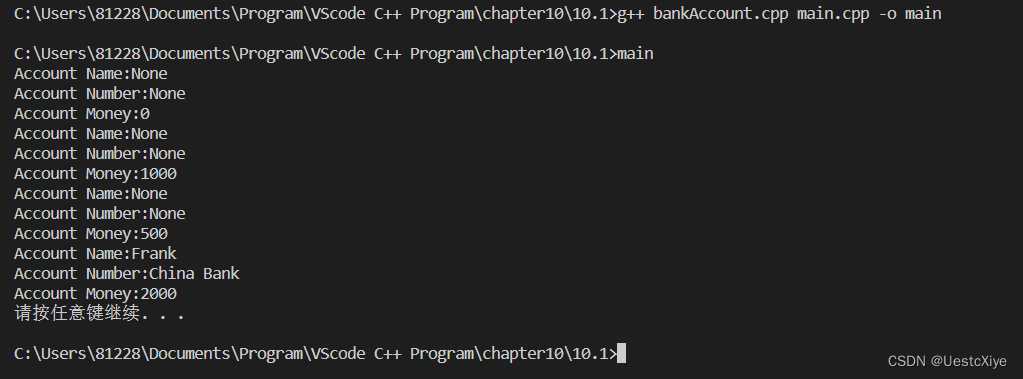
2. Person类
下面是一个非常简单的类定义:
class Person
{
private:
static const int LIMIT = 25;
string lname; // Person’s last name
char fname[LIMIT]; // Person’s first name
public:
Person() {lname = ""; fname[0] = '\0';}; // #1
Person(const string & ln, const char * fn = "Heyyou"); // #2
// the following methods display lname and fname
void Show() const; // firstname lastname format
void FormalShow() const; // lastname, firstname format
};
它使用了一个string对象和一个字符数组,让您能够比较它们的用法。请提供未定义的方法的代码,以完成这个类的实现。
再编写一个使用这个类的程序,它使用了三种可能的构造函数的调用(没有参数、一个参数和两个参数)以及两种显示方法。
下面是一个使用这些构造函数和方法的例子:
Person one; // use default constructor
Person two("Smythecraft"); // use #2 with one default argument
Person three("Dimwiddy", "Sam"); // use #2, no defaults one.Show();
cout << endl;
one.FormalShow();
// etc. for two and three
代码:
person.h:
#ifndef PERSON_H
#define PERSON_H
#include <iostream>
#include <cstring>
using namespace std;
class Person
{
private:
static const int LIMIT = 25;
string lname;
char fname[LIMIT];
public:
Person()
{
lname = "";
fname[0] = '\0';
};
Person(const string &ln, const char *fn = "Heyyou");
void Show() const;
void FormalShow() const;
};
#endif
person.cpp:
#include "person.h"
#include <iostream>
#include <cstring>
using namespace std;
Person::Person(const string &ln, const char *fn)
{
lname = ln;
strcpy_s(fname, LIMIT, fn);
}
void Person::Show() const
{
cout << fname << " " << lname << endl;
}
void Person::FormalShow() const
{
cout << lname << " , " << fname << endl;
}
main.cpp:
#include "person.h"
#include <iostream>
int main(void)
{
Person one;
Person two("Smythecraft");
Person three("Dimwiddy", "Sam");
one.Show();
cout << endl;
one.FormalShow();
two.Show();
cout << endl;
two.FormalShow();
three.Show();
cout << endl;
three.FormalShow();
system("pause");
return 0;
}
运行结果:
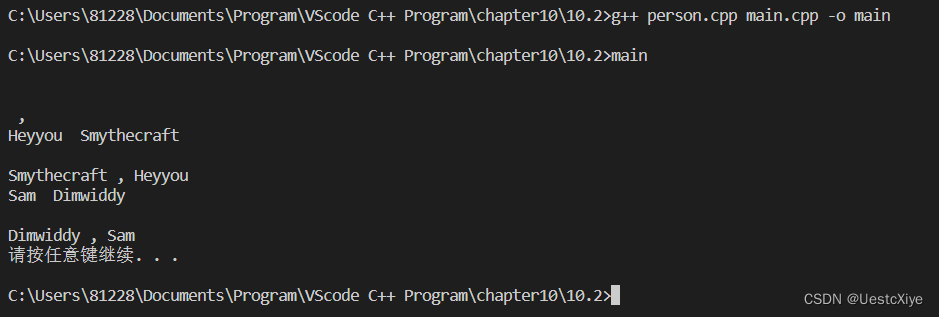
3. golf类
完成第9章的编程练习1,但要用正确的golf类声明替换那里的代码。用带合适参数的构造函数替换setgolf(golf&, const char*, int),以提供初始值。保留setgolf()的交互版本,但要用构造函数来实现它(例如,setgolf()的代码应该获得数据,将数据传递给构造函数来创建一个临时对象,并将其赋给调用对象,即*this)。
代码:
golf.h:
#ifndef GOLF_H
#define GOLF_H
#include <iostream>
using namespace std;
class Golf
{
private:
static const int Len = 40;
char fullname[Len];
int handicap;
public:
Golf();
Golf(const char *fl, const int h = 0);
void setHandicap(const int hc);
void showgolf() const;
};
#endif
golf.cpp:
#include "golf.h"
#include <iostream>
#include <cstring>
using namespace std;
Golf::Golf()
{
char fn[Len];
int h;
cout << "Please enter the full name of player: ";
cin.getline(fn, Len);
cout << "Please enter the handicap of player: ";
cin >> h;
cin.get();
*this = Golf(fn, h);
}
Golf::Golf(const char *fl, const int h)
{
strcpy_s(fullname, Len, fl);
handicap = h;
}
void Golf::setHandicap(const int hc)
{
handicap = hc;
}
void Golf::showgolf() const
{
cout << "Information:\n";
cout << "Full name: " << fullname << endl;
cout << "Handicap: " << handicap << endl;
}
main.cpp:
#include "golf.h"
#include <iostream>
using namespace std;
int main()
{
Golf ann("Ann Birdfree", 24);
ann.showgolf();
Golf andy;
andy.showgolf();
andy.setHandicap(40);
andy.showgolf();
system("pause");
return 0;
}
运行结果:
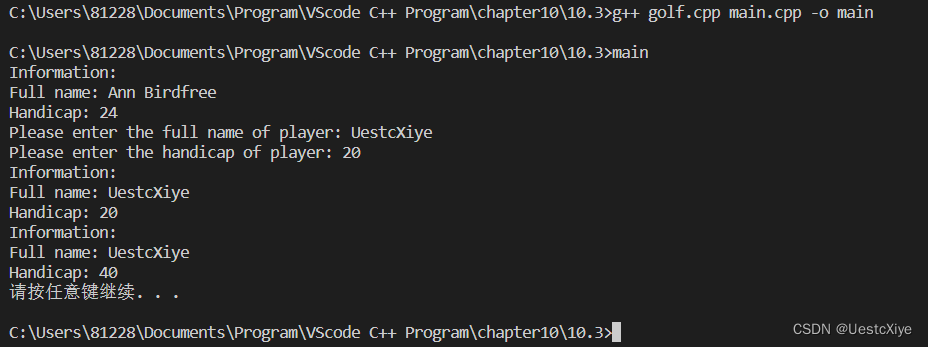
4. Sales类
代码:
sales.h:
#ifndef SALES_H
#define SALES_H
namespace SALES
{
class Sales
{
private:
static const int QUARTERS = 4;
double sales[QUARTERS];
double average;
double max;
double min;
public:
Sales();
Sales(const double ar[], const int n);
void showSales() const;
};
}
#endif
sales.cpp:
#include "sales.h"
#include <iostream>
using namespace std;
namespace SALES
{
Sales::Sales(const double ar[], const int n) // 非交互式版本
{
if (n < 4)
{
for (int i = 0; i < n; i++)
sales[i] = ar[i];
for (int j = n; j < 4; j++)
sales[j] = 0;
}
else
{
for (int i = 0; i < 4; i++)
sales[i] = ar[i];
}
average = (sales[0] + sales[1] + sales[2] + sales[3]) / 4;
double t_max = 0.0;
double t_min = 1000000;
for (int i = 0; i < 4; i++)
{
if (sales[i] > t_max)
t_max = sales[i];
if (sales[i] < t_min)
t_min = sales[i];
}
max = t_max;
min = t_min;
}
Sales::Sales() // 交互式版本
{
cout << "Enter sales:\n";
for (int i = 0; i < 4; i++)
{
cout << "The #" << i + 1 << " quarter is: ";
cin >> sales[i];
}
average = (sales[0] + sales[1] + sales[2] + sales[3]) / 4;
double t_max = 0.0;
double t_min = 1000000;
for (int i = 0; i < 4; i++)
{
if (sales[i] > t_max)
t_max = sales[i];
if (sales[i] < t_min)
t_min = sales[i];
}
max = t_max;
min = t_min;
}
void Sales::showSales() const
{
cout << "The sales of 4 quarters are $" << sales[0] << ", $" << sales[1] << ", $" << sales[2] << ", $" << sales[3] << endl;
cout << "Average:" << average << endl;
cout << "Max:" << max << endl;
cout << "Min:" << min << endl;
}
}
main.cpp:
#include "sales.h"
#include <iostream>
using namespace SALES;
using namespace std;
int main()
{
Sales s1;
double ar[3] = {10, 20, 30};
Sales s2(ar, 3);
cout << "#1:" << endl;
s1.showSales();
cout << "--------------------------------------------------" << endl;
cout << "#2:" << endl;
s2.showSales();
system("pause");
return 0;
}
运行结果:
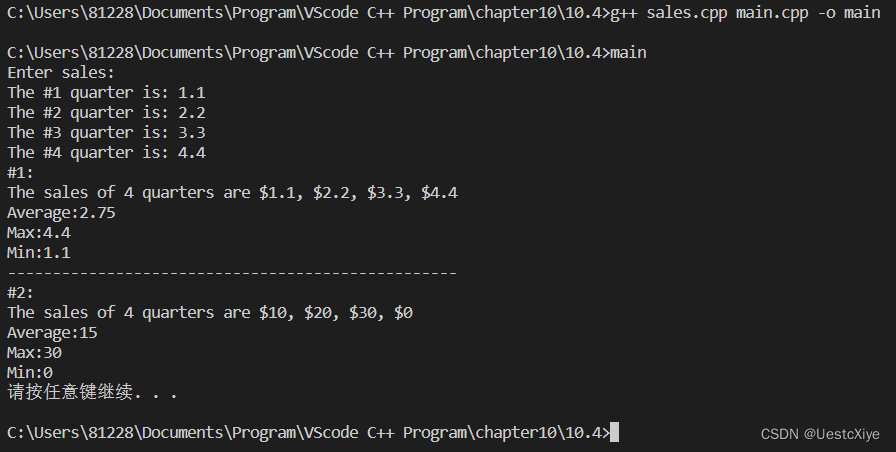
5. costom
考虑下面的结构声明:
struct customer{
char fullname[35];
double payment;
};
编写一个程序,它从栈中添加和删除customer结构(栈用Stack类声明表示)。每次customer结构被删除时,其payment的值都将被加入到总数中,并报告总数。
注意:应该可以直接使用Stack类而不作修改;只需修改typedef声明,使Item的类型为customer,而不是unsigned long即可。
代码:
stack.h:
#ifndef STACK10_H_
#define STACK10_H_
#include <iostream>
struct customer
{
char fullname[35];
double payment;
};
typedef customer Item;
class Stack
{
private:
enum{MAX = 10};
Item items[MAX];
int top;
public:
Stack();
bool isempty() const;
bool isfull() const;
bool push(const Item& item);
bool pop(Item& item);
};
#endif // !STACK_H_
stack.cpp:
#include "stack10.h"
Stack::Stack()
{
top = 0;
}
bool Stack::isempty() const
{
return top == 0;
}
bool Stack::isfull() const
{
return top == MAX;
}
bool Stack::push(const Item& item)
{
if (top < MAX)
{
items[top++] = item;
return true;
}
else
return false;
}
bool Stack::pop(Item& item)
{
if (top > 0)
{
item = items[--top];
return true;
}
else
return false;
}
main.cpp:
#include "stack.h"
#include <iostream>
#include <cctype>
using namespace std;
int main()
{
Stack st;
char ch;
customer po;
double total_payment = 0.0;
cout << "Please enter A to add a purchase order,\n";
cout << "P to process a PO, or Q to quit.\n";
while (cin >> ch && toupper(ch) != 'Q')
{
while (cin.get() != '\n')
continue;
if (!isalpha(ch))
{
cout << "\a";
continue;
}
switch (ch)
{
case 'A':
case 'a':
cout << "Enter the name of customer: ";
cin.getline(po.fullname, 30);
cout << "Enter the payment: ";
cin >> po.payment;
cin.get();
if (st.isfull())
cout << "Stack already full.\n";
else
st.push(po);
break;
case 'P':
case 'p':
if (st.isempty())
cout << "stack already empty.\n";
else
{
total_payment += po.payment;
st.pop(po);
cout << "PO {" << po.fullname << ", " << po.payment << "} popped.\n";
}
break;
}
cout << "Please enter A to add a purchase order,\n";
cout << "P to Process a PO, or Q to quit.\n";
}
cout << "Bye!\n";
system("pause");
return 0;
}
运行结果:
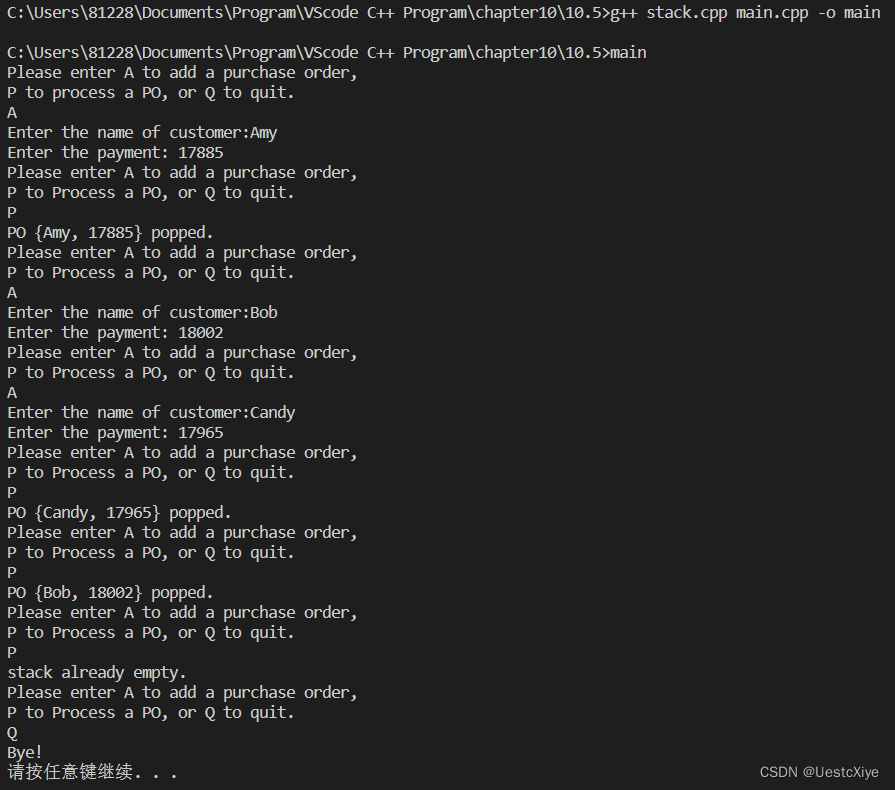
6. Move类
下面是一个类声明:
class Move
{
private:
double x;
double y;
public:
Move(double a = 0, double b = 0); // sets x, y to a, b
showmove() const; // shows current x,y values
Move add(const Move & m) const;
// this function adds x of m to x of invoking object to get new x,
// adds y of m to y of invoking object to get new y, creates a new
// move object initialized to new x, y values and returns it
//此函数将m的x加到调用对象的x以获取新的x,将m的y添加到调用对象的y中以获得新的y,
//创建一个新的对象,并将对象初始化为新的x,y值并返回它
reset(double a = 0, double b = 0); // resets x,y to a, b
};
请提供成员函数的定义和测试这个类的程序。
代码:
move.h:
#ifndef MOVE_H
#define MOVE_H
class Move
{
private:
double x;
double y;
public:
Move(double a = 0, double b = 0);
void showmove() const;
Move add(const Move &m) const;
void reset(double a = 0, double b = 0);
};
#endif
move.cpp:
#include "move.h"
#include <iostream>
Move::Move(double a, double b)
{
x = a;
y = b;
}
void Move::showmove() const
{
using std::cout;
using std::endl;
cout << "x:" << x << endl;
cout << "y:" << y << endl;
}
Move Move::add(const Move &m) const
{
return Move(x + m.x, y + m.y);
}
void Move::reset(double a, double b)
{
x = a;
y = b;
}
main.cpp:
#include "move.h"
#include <iostream>
using namespace std;
int main()
{
Move a(1, 1);
Move b(2.3, 3.4);
a.showmove();
b.showmove();
Move c = a.add(b);
c.showmove();
system("pause");
return 0;
}
运行结果:

7. Plorg类
Betelgeusean plorg有这些特征。
数据:
- plorg的名称不超过19个字符
- plorg的满意指数(CI),这是一个整数
操作:
- 新的plorg将有名称,其CI值为50
- plorg的CI可以修改
- plorg可以报告其名称和CI
请编写一个Plorg类声明(包括数据成员和成员函数原型)来表示plorg,并编写成员函数的函数定义。然后编写一个小程序,以演示Plorg类的所有特性。
代码:
plorg.h:
#ifndef PLORG_H
#define PLORG_H
#include <iostream>
class Plorg
{
private:
static const int LEN = 19;
char name[LEN];
int ci;
public:
Plorg();
Plorg(const char *str,const int c_i=50);
void setCI(const int c_i);
void show()const;
};
#endif
plorg.cpp:
#include "plorg.h"
#include <iostream>
#include <cstring>
Plorg::Plorg()
{
strcpy_s(name, LEN, "Plorga");
ci = 0;
}
Plorg::Plorg(const char *str, const int c_i)
{
strcpy_s(name, LEN, str);
ci = c_i;
}
void Plorg::setCI(const int c_i)
{
ci = c_i;
}
void Plorg::show() const
{
using std::cout;
using std::endl;
cout << "Name:" << name << endl;
cout << "CI:" << ci << endl;
}
main.cpp:
#include "plorg.h"
#include <iostream>
using namespace std;
int main()
{
Plorg p1;
p1.show();
p1.setCI(100);
p1.show();
Plorg p2("Amazon", 10);
p2.show();
system("pause");
return 0;
}
运行结果:
8. List类
可以将简单列表描述成下面这样:
- 可存储0或多个某种类型的列表;
- 可创建空列表;
- 可在列表中添加数据项;
- 可确定列表是否为空;
- 可确定列表是否为满;
- 可访问列表中的每一个数据项,并对它执行某种操作。
可以看到,这个列表确实很简单,例如,它不允许插入或删除数据项。
请设计一个List类来表示这种抽象类型。您应提供头文件list.h和实现文件list.cpp,前者包含类定义,后者包含类方法的实现。您还应该创建一个简短的程序来使用这个类。
该列表的规范很简单,这个主要旨在简化这个编程练习。可以选择使用数组或链表来实现该列表,但公有接口不应依赖于所做的选择。也就是说,公有接口不应有数组索引、节点指针等。应使用通用概念来表达创建列表、在列表中添加数据项等操作。对于访问数据项以及执行操作,通常应使用将函数指针作为参数的函数来处理:
void visit(void (*pf)(Item &));
其中,pf指向一个将Item引用作为参数的函数(而不是成员函数),Item是列表中数据项的类型。visit()函数将该函数用于列表中的每个数据项。
代码:
list.h:
#ifndef LIST_H
#define LIST_H
#include <iostream>
#include <cstring>
using namespace std;
struct customer
{
string name;
double consumption;
};
typedef customer Item;
class List
{
private:
static const int LEN = 20;
Item items[LEN];
int top = 0;
public:
List();
bool isEmpty() const;
bool isFull() const;
bool add(const Item &item);
void visit(void (*pf)(Item &item));
void show() const;
};
void total(Item &item); // 计算总营业额(列表中所有顾客消费额相加)
#endif
list.cpp:
#include "list.h"
#include <iostream>
#include <cstring>
using namespace std;
double sum = 0.0;
List::List()
{
top = 0;
}
bool List::isEmpty() const
{
return top == 0;
}
bool List::isFull() const
{
return top == Len;
}
bool List::add(const Item &item)
{
if (top < Len)
{
items[top++] = item;
return true;
}
else
return false;
}
void List::show() const
{
for (int i = 0; i < top; i++)
{
cout << "#" << i + 1 << ":" << endl;
cout << "Name: " << items[i].name << endl;
cout << "Consumption: " << items[i].consumption << endl;
}
}
void List::visit(void (*pf)(Item &item))
{
for (int i = 0; i < top; i++)
{
pf(items[i]);
}
}
void total(Item &item)
{
sum += item.consumption;
}
main.cpp:
#include "list.h"
#include <iostream>
using namespace std;
extern double sum;
int main()
{
List st;
char ch;
customer po;
cout << "Please enter A to add a purchase order, V to calculate the turnover, S to show the items, or Q to quit.\n";
while (cin >> ch && toupper(ch) != 'Q')
{
while (cin.get() != '\n')
continue;
if (!isalpha(ch))
{
cout << "\a";
continue;
}
switch (ch)
{
case 'A':
case 'a':
cout << "Enter the name of customer: ";
getline(cin, po.name);
cout << "Enter the payment: ";
cin >> po.consumption;
cin.get();
if (st.isFull())
cout << "List already full.\n";
else
st.add(po);
break;
case 'S':
case 's':
st.show();
break;
case 'V':
case 'v':
if (st.isEmpty())
{
cout << "List is empty.\n";
}
else
{
st.visit(total);
cout << "sum = " << sum << endl;
}
}
cout << "Please enter A to add a purchase order, V to calculate the turnover, S to show the items, or Q to quit.\n";
}
cout << "Bye!\n";
system("pause");
return 0;
}
运行结果:
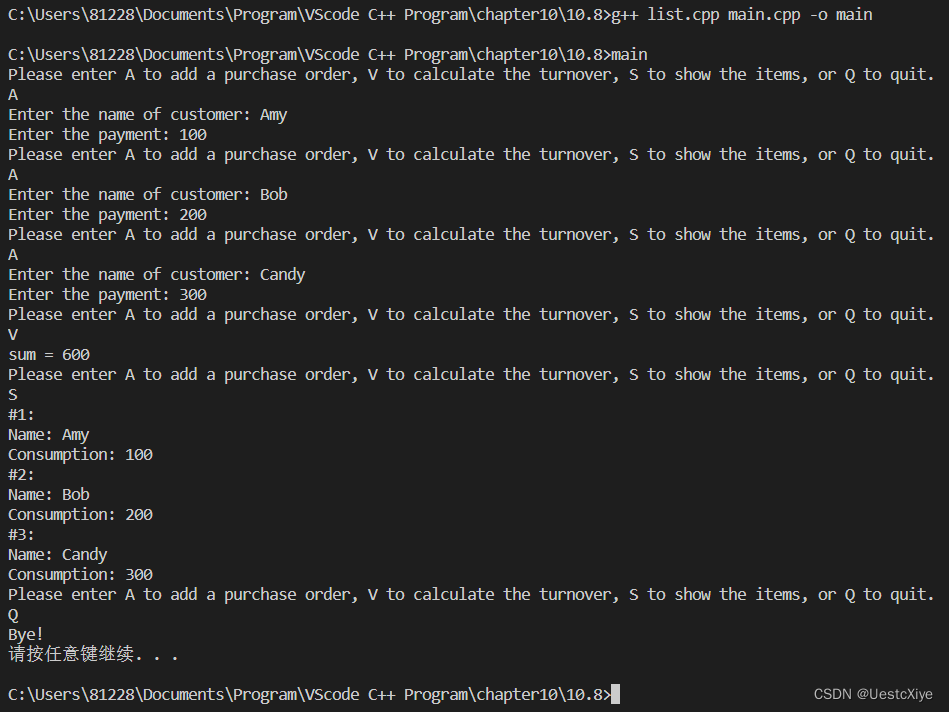
























 被折叠的 条评论
为什么被折叠?
被折叠的 条评论
为什么被折叠?










